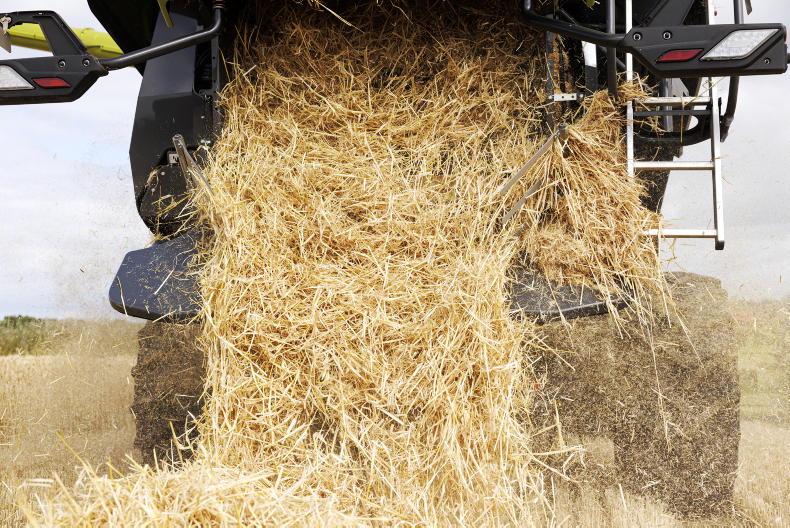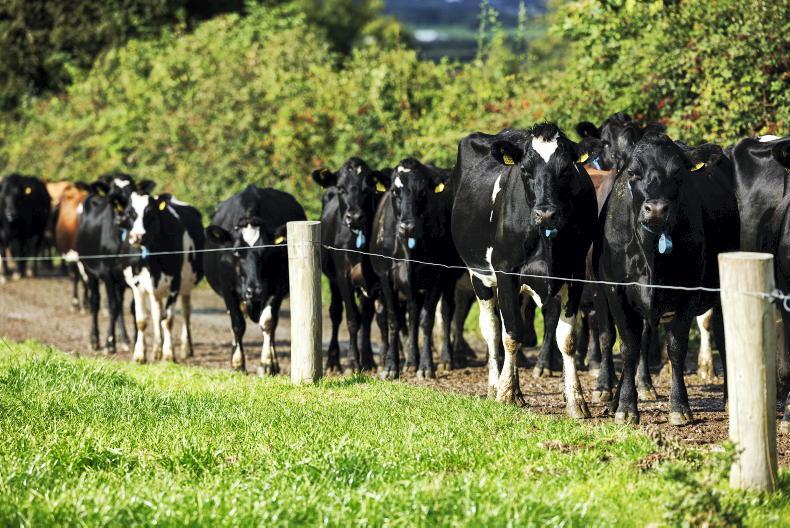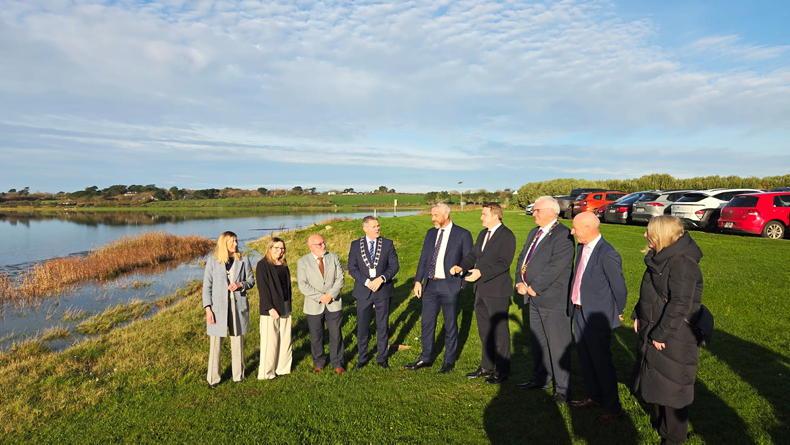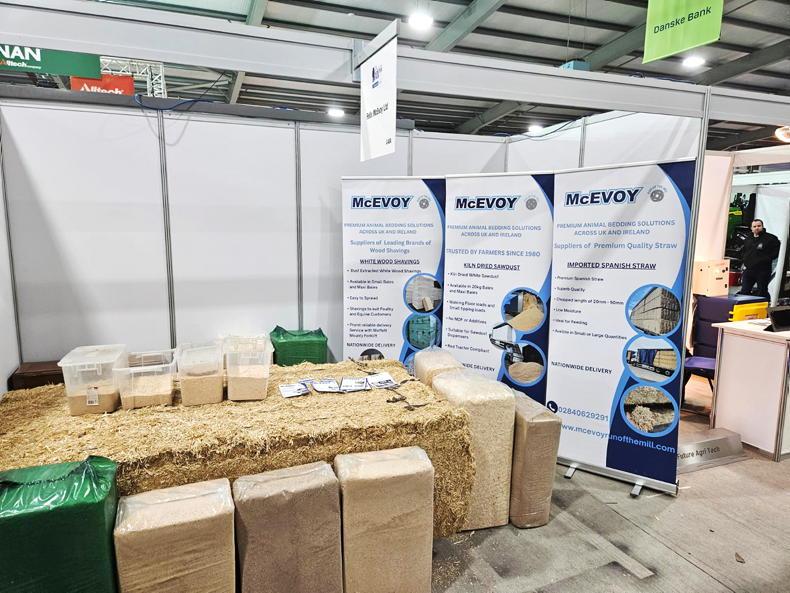With the 2023 harvest now well underway, it is important to decide what is happening your straw before the combine moves. Chopping is unlikely for most winter barley growers because of the volume of straw present and the relative ease with which it can be gathered, baled and moved.
The volume of straw following a winter barley crop is a lot to handle in the early years of straw incorporation.
It can be difficult to physically incorporate and it can leave the seedbed very loose, open and potentially subject to uneven germination in dry conditions, especially with min-till cultivation. Slugs can also be a problem in such conditions. Most growers see straw as an asset that carries a value. But the value numbers have changed and so the decision must be evaluated.
Most tillage land is being mined of nutrients as all the produce is moved off the land. Those who incorporate straw go some way to returning some nutrients and also organic matter. Organic manures and cover crops also help to do this.
Why sell straw
Income is the main reason why most straw is sold. Many growers have built up a regular demand for straw, either from locals or from dependable customers.
Some growers do not have choppers fitted to combines and so they cannot chop at cutting time. This is really the only time to chop to get a uniform spread.
Many farms may not have cultivators capable of straw incorporation, but most stubbles will have to be cultivated this autumn as part of the new nitrates requirement. It should be noted that straw becomes much easier to handle after a few years of incorporation, because the biology in the soil will pull it down within a few weeks of harvest. It is almost liek it melts.
Why chop straw
There are many reasons why growers opt to chop some or all of their straw. The main reasons are to return organic matter and nutrients to the soil. Incorporated straw helps to keep the soil open and loose, which helps water percolation and root growth. It also makes the soil easier to till, thus reducing annual fuel requirement for establishment, regardless of the system used.
Straw is a fantastic stimulant for the multiplication of earthworms, which are hugely advantageous.
They help to improve soil structure on worn ground, which also helps to reduce energy requirement. Good soil structure is critical for maximum root growth to help varieties achieve their genetic potential.
Earthworm activity is very important to help feed all other soil organisms and if they cast deep in the profile, the organic matter they deposit is less at risk of loss of carbon.
Chopping returns a substantial amount of nutrients, mainly K with some P, a little nitrogen, an unknown amount of trace elements and a substantial amount of carbon.
Stubble cultivation and straw incorporation have many other benefits, such as reducing the soil weed-seed bank, destroying eggs of pests like slugs and leatherjackets, straw degradation begins sooner and a second or third cultivation will act to further reduce viable weed seeds in the ground.
Universal figures indicate that straw is roughly 10% P and about 50% K. These universal figures are based on UK straw assessment values and I often wonder if our values are actually higher because straw here is normally less mature at harvest.
The less ripe straw is at cutting, the more nutrient is likely to be present in stems and leaves. Oats is a specific example of that.
Using Teagasc values, the examples in Table 1 show the crop P and K removal in straw as the difference between the crop recommendations where straw baled or incorporated.
Using these values, an 11t/ha winter wheat crop takes off 42kg P/ha and 108kg K/ha. Where the straw is not removed, these off-takes drop to 37 and 52 kg/ha respectively. So by incorporating the straw, P and K removal is decreased by 5kg of P and 56kg of K per hectare.
This saving is then valued based on the cost of Superphosphate and Muriate of Potash, as shown in Table 1. Based on these values, the nutrient removal in baled straw is €139.21/ha in the 11t winter wheat crop. Equivalent values for other crops are shown in Table 1.
The numbers for oats are much higher because of the high K content in the straw.
While these removal values are big, it has been my experience that it takes a few years for soil K levels to show the benefit of chopping in soil test results, even when applying full straw removal rates.
Working back to the value of the straw
What does this mean in terms of the net value of the straw? Table 2 shows generic numbers for potential straw sales in terms of bales per acre for the four different crops. I am using a baling cost of €6/bale (4x4 round) as indicated by the Association of Farm and Forestry Contractors in Ireland (FCI).
While some may deem this high, it seems reasonable, on average, given how often some degree of turning is needed to get straw baled. So the baling cost per hectare is the number of bales multiplied by the cost per bale.
Using a selling price of €20 or €16 /bale to value straw sales per hectare for the different crops (Table 2), I subtract the cost of baling and the value of the nutrients from the straw sale value. This leaves a net value for straw sold as €238.79/ha for winter wheat and €113.11/ha for oats.
Dividing these values by the number of bales sold, all you get for the straw in your bale is €8.84 for wheat and €3.37/bale for the oats. So there is a lot of cost or foregone expenditure attached to making bales.
Also, we have not accounted for the value of soil improvement and future diesel savings in these figures.

Winter barley produces a lot of straw to try to handle in the early years of incorporation. \ Donal O'Leary
Carbon and compaction
An increasing number of growers have become very conscious of the impact of soil damage caused by heavy machinery during baling and removing straw. This has caused some of them to cease baling and move to straw incorporation to help get their land into better physical condition.
Chopping and incorporation also come with a cost. Both require additional diesel and incorporation is important post chopping to initiate straw breakdown. This is especially important in the early years of incorporation but less so as the practice continues.
The FIC charges suggest an additional €12.50/ha to chop straw during harvesting and up to €80/ha for cultivation. That’s over €90/ha but much lower than the savings on nutrient off-take.
We must also consider the impact of straw on soil carbon level. Teagasc estimate that a standard crop of incorporated straw would leave a net 500kg of carbon per hectare. If carbon trades at €80/t this would mean a potential annual income of €40/ha.
The process of building soil organic matter or carbon is slow and incremental. In some recent presentations, Patrick Forrestal of Teagasc presented an interesting piece of work conducted by Lars Stouman Jensen at the University of Copenhagen.
This showed graphically (Figure 1) the impact of continuous annual application of organic manure to the accumulated organic nitrogen in residual manure in soil. Put simply, the value increases with each successive application but a little more is lost each time due to the activity of soil microorganisms.
Basically each sequential application increases the accumulated organic N level in the soil but more gets lost each year as the level increases. The response moves to a plateau effect over time but this is likely to take longer on worn tillage soils (Figure 1).
Soil health and natural soil fertility increase with continuous application of animal manure in this instance but the same response is likely to hold true for many organic matter sources. The dotted lines in figure 1 indicate the likely reduction from that point if no further applications are made. So real soil improvements have a long beneficial effect.
The overall build of soil carbon is likely to follow a relatively similar pattern to Figure 1 but farmers need to have an official baseline assessment done before attempting to increase soil C levels so that they can be rewarded for increasing soil C storage in future years.
Straw contains roughly 10% P and 50% K.Decisions around straw should be assessed on the sale value of the actual straw and the replacement cost of the nutrients removed.At €20/4x4 bale, the actual value of the straw sold is just over €10/bale.Straw incorporation is a slow and incremental way to build soil carbon but it quickly reduces diesel and metal requirements for all soil engagement work.
With the 2023 harvest now well underway, it is important to decide what is happening your straw before the combine moves. Chopping is unlikely for most winter barley growers because of the volume of straw present and the relative ease with which it can be gathered, baled and moved.
The volume of straw following a winter barley crop is a lot to handle in the early years of straw incorporation.
It can be difficult to physically incorporate and it can leave the seedbed very loose, open and potentially subject to uneven germination in dry conditions, especially with min-till cultivation. Slugs can also be a problem in such conditions. Most growers see straw as an asset that carries a value. But the value numbers have changed and so the decision must be evaluated.
Most tillage land is being mined of nutrients as all the produce is moved off the land. Those who incorporate straw go some way to returning some nutrients and also organic matter. Organic manures and cover crops also help to do this.
Why sell straw
Income is the main reason why most straw is sold. Many growers have built up a regular demand for straw, either from locals or from dependable customers.
Some growers do not have choppers fitted to combines and so they cannot chop at cutting time. This is really the only time to chop to get a uniform spread.
Many farms may not have cultivators capable of straw incorporation, but most stubbles will have to be cultivated this autumn as part of the new nitrates requirement. It should be noted that straw becomes much easier to handle after a few years of incorporation, because the biology in the soil will pull it down within a few weeks of harvest. It is almost liek it melts.
Why chop straw
There are many reasons why growers opt to chop some or all of their straw. The main reasons are to return organic matter and nutrients to the soil. Incorporated straw helps to keep the soil open and loose, which helps water percolation and root growth. It also makes the soil easier to till, thus reducing annual fuel requirement for establishment, regardless of the system used.
Straw is a fantastic stimulant for the multiplication of earthworms, which are hugely advantageous.
They help to improve soil structure on worn ground, which also helps to reduce energy requirement. Good soil structure is critical for maximum root growth to help varieties achieve their genetic potential.
Earthworm activity is very important to help feed all other soil organisms and if they cast deep in the profile, the organic matter they deposit is less at risk of loss of carbon.
Chopping returns a substantial amount of nutrients, mainly K with some P, a little nitrogen, an unknown amount of trace elements and a substantial amount of carbon.
Stubble cultivation and straw incorporation have many other benefits, such as reducing the soil weed-seed bank, destroying eggs of pests like slugs and leatherjackets, straw degradation begins sooner and a second or third cultivation will act to further reduce viable weed seeds in the ground.
Universal figures indicate that straw is roughly 10% P and about 50% K. These universal figures are based on UK straw assessment values and I often wonder if our values are actually higher because straw here is normally less mature at harvest.
The less ripe straw is at cutting, the more nutrient is likely to be present in stems and leaves. Oats is a specific example of that.
Using Teagasc values, the examples in Table 1 show the crop P and K removal in straw as the difference between the crop recommendations where straw baled or incorporated.
Using these values, an 11t/ha winter wheat crop takes off 42kg P/ha and 108kg K/ha. Where the straw is not removed, these off-takes drop to 37 and 52 kg/ha respectively. So by incorporating the straw, P and K removal is decreased by 5kg of P and 56kg of K per hectare.
This saving is then valued based on the cost of Superphosphate and Muriate of Potash, as shown in Table 1. Based on these values, the nutrient removal in baled straw is €139.21/ha in the 11t winter wheat crop. Equivalent values for other crops are shown in Table 1.
The numbers for oats are much higher because of the high K content in the straw.
While these removal values are big, it has been my experience that it takes a few years for soil K levels to show the benefit of chopping in soil test results, even when applying full straw removal rates.
Working back to the value of the straw
What does this mean in terms of the net value of the straw? Table 2 shows generic numbers for potential straw sales in terms of bales per acre for the four different crops. I am using a baling cost of €6/bale (4x4 round) as indicated by the Association of Farm and Forestry Contractors in Ireland (FCI).
While some may deem this high, it seems reasonable, on average, given how often some degree of turning is needed to get straw baled. So the baling cost per hectare is the number of bales multiplied by the cost per bale.
Using a selling price of €20 or €16 /bale to value straw sales per hectare for the different crops (Table 2), I subtract the cost of baling and the value of the nutrients from the straw sale value. This leaves a net value for straw sold as €238.79/ha for winter wheat and €113.11/ha for oats.
Dividing these values by the number of bales sold, all you get for the straw in your bale is €8.84 for wheat and €3.37/bale for the oats. So there is a lot of cost or foregone expenditure attached to making bales.
Also, we have not accounted for the value of soil improvement and future diesel savings in these figures.

Winter barley produces a lot of straw to try to handle in the early years of incorporation. \ Donal O'Leary
Carbon and compaction
An increasing number of growers have become very conscious of the impact of soil damage caused by heavy machinery during baling and removing straw. This has caused some of them to cease baling and move to straw incorporation to help get their land into better physical condition.
Chopping and incorporation also come with a cost. Both require additional diesel and incorporation is important post chopping to initiate straw breakdown. This is especially important in the early years of incorporation but less so as the practice continues.
The FIC charges suggest an additional €12.50/ha to chop straw during harvesting and up to €80/ha for cultivation. That’s over €90/ha but much lower than the savings on nutrient off-take.
We must also consider the impact of straw on soil carbon level. Teagasc estimate that a standard crop of incorporated straw would leave a net 500kg of carbon per hectare. If carbon trades at €80/t this would mean a potential annual income of €40/ha.
The process of building soil organic matter or carbon is slow and incremental. In some recent presentations, Patrick Forrestal of Teagasc presented an interesting piece of work conducted by Lars Stouman Jensen at the University of Copenhagen.
This showed graphically (Figure 1) the impact of continuous annual application of organic manure to the accumulated organic nitrogen in residual manure in soil. Put simply, the value increases with each successive application but a little more is lost each time due to the activity of soil microorganisms.
Basically each sequential application increases the accumulated organic N level in the soil but more gets lost each year as the level increases. The response moves to a plateau effect over time but this is likely to take longer on worn tillage soils (Figure 1).
Soil health and natural soil fertility increase with continuous application of animal manure in this instance but the same response is likely to hold true for many organic matter sources. The dotted lines in figure 1 indicate the likely reduction from that point if no further applications are made. So real soil improvements have a long beneficial effect.
The overall build of soil carbon is likely to follow a relatively similar pattern to Figure 1 but farmers need to have an official baseline assessment done before attempting to increase soil C levels so that they can be rewarded for increasing soil C storage in future years.
Straw contains roughly 10% P and 50% K.Decisions around straw should be assessed on the sale value of the actual straw and the replacement cost of the nutrients removed.At €20/4x4 bale, the actual value of the straw sold is just over €10/bale.Straw incorporation is a slow and incremental way to build soil carbon but it quickly reduces diesel and metal requirements for all soil engagement work. 









SHARING OPTIONS